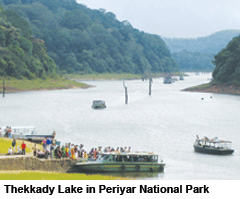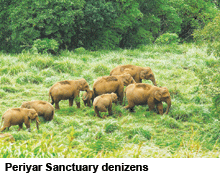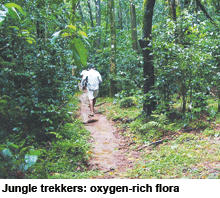Spread over an area of 925 sq.km, the Periyar National Park is Kerala’s largest wildlife sanctuary attracting millions of domestic and foreign tourists annually
 The bus laboriously wound its way up the steep and winding mountain path as the sun lazily rose through the dense forest, piercing the early morning mist. As we climbed higher, a brilliant panoramic view of verdant fields opened up below. Half an hour later, the bus pulled into Kumily, a sleepy township in Kerala’s Idukki district just across the border with Tamil Nadu and base for most visitors to the Periyar National Park. Spread over an area of 925 sq. km, the park is Kerala’s largest wildlife sanctuary and repository of a glory of tropical flora and fauna.
The bus laboriously wound its way up the steep and winding mountain path as the sun lazily rose through the dense forest, piercing the early morning mist. As we climbed higher, a brilliant panoramic view of verdant fields opened up below. Half an hour later, the bus pulled into Kumily, a sleepy township in Kerala’s Idukki district just across the border with Tamil Nadu and base for most visitors to the Periyar National Park. Spread over an area of 925 sq. km, the park is Kerala’s largest wildlife sanctuary and repository of a glory of tropical flora and fauna.
Kumily (pop.31,000) seems to have vastly expanded since my last visit almost a decade ago. Dozens of hotels and lodges — catering to every budget — have sprouted across the town, as have eateries and massage and ayur-vedic spas. An amiable autorickshaw driver guided me to a delightful, modestly-priced homestay, where I was to spend the next seven days in near-perfect serendipity. All along the road leading to the sanctuary, old bungalows have been tastefully converted into travel inns for tourists, mostly forei-gners, and are evidently doing brisk business. Some innovative locals have even constructed eco-friendly houses atop enormous trees — simple but steeply-priced accommodation for travellers with a taste for adventure.
From Kumily to the boat jetty of Thekkady lake, the centre of the tourist zone within the Periyar reserve where visitors are allowed access, was a pleasant 4-km walk, with almost impenetrable jungle on either side of the road. Birdsong uninhibitedly pervaded the thickets. A party of racket-tailed Drongos — graceful avians with tails shaped like spoons — floated in the clear sky; giant spiders lazed in intricately woven webs which hung like blankets from huge trees; a battalion of crickets kept up an incessant chatter; dozens of gaily-painted butterflies and electric-hued dragonflies flitted about while black-faced monkeys swung from tree to tree chattering excitedly. Suddenly, a slender hornbill flew across and disappeared into the forest and as I tried desperately to trace its path, I spotted a pair of bushy-tailed pale red Malabar squirrels snoozing high up in a tree.
Unlike in other wildlife sanctuaries in India, where movement is greatly restricted, there is a lot tourists can do in the Periyar National Park — thanks to the enterprise of the park authorities, who have developed novel homespun attractions for visitors without scarring the landscape. A two-hour boat ride (Rs.40), across the vast lake that was formed when the Mulla-periyar dam on the Periyar river was constructed more than a century ago, is the most popular recreational resource.
Early mornings and late evenings are the best time to take the boat ride. Turtles sunning on the rocky banks, shoals of fish darting about in the muddy waters and slender-necked water birds nesting on shafts of dead trees jutting out of the lake, remain etched in memory. The placid water shimmers with the soft light of the sun; barring gentle waves produced by the boat, nothing else moves, and I’m immersed in the tranquil surroundings.
Onshore, packs of wild boar and spotted deer are commonplace. As the boat gently moves further down, a vast family of majestic gaur or Indian bison can be seen drinking from the lake. A little ahead, a lone elephant came into view, but, averse to company, slid back into the jungle.
 For the more adventurous, park authorities offer several guided and affordable trekking options. These include a one or two-day trekking and camping experience deep inside the park; a one-day trek-cum-rafting expedition; and a night trek patrolling the jungle. I chose the easiest option — a three-hour trek — of crossing the lake on a raft made of bamboos strapped together and then heading deep into the forest.
For the more adventurous, park authorities offer several guided and affordable trekking options. These include a one or two-day trekking and camping experience deep inside the park; a one-day trek-cum-rafting expedition; and a night trek patrolling the jungle. I chose the easiest option — a three-hour trek — of crossing the lake on a raft made of bamboos strapped together and then heading deep into the forest.
No sooner did we step off the raft than I was assailed by a horde of leeches — slender pink-coloured worm-like creatures — that comically bounced their way to my feet. The ground, I noticed to my horror, was littered with these blood-thirsty creatures, dancing from leaf to leaf in search of gore. Monachan, our amiable guide, had provided us with special socks and tobacco powder to turn off these blood suckers, but they proved an insufficient deterrent as we trudged ahead.
After a point, the narrow path opened out into a dark forest with dense undergrowth and a brooding, secret air. We pushed ahead oblivious that predators might be lurking behind the next bush. An hour later we were in the heart of the forest, a wild, natural greenhouse with a profusion of oxygen-rich flora. Under the canopy of forest cover, it was dark and humid with only a few slivers of sunlight filtering through. Enormous bee-hives hung from giant trees and wild cardamom bushes grew in rich abundance.
The whoops of invisible monkeys pierced the eerie silence, punctuated by the machine-gun rattle of an energetic woodpecker. A sharp-edged quill and abundant droppings indicated that a porcupine had passed by. In the distance, I spotted a lone bison grazing. Although the sanctuary boasts many species of fauna — including tigers, leopards, sloth bears and wild dogs — it’s rare to spot them during short treks.
Two hours later, we emerged from the forest onto a grassy plain on the banks of Thekkady lake. A band of tribesmen with infinite patience sat on their haunches, their fishing rods dipped in the water. An army of cormorants took off from the lake and headed in the direction of the surrounding hills.
 I had initially expected that budgeting a week in Kumily was excessive, but time flew on fleet wings and before I knew it, it was time to return home. Most days, I spent lazy mornings exploring the town or walking through the forest. One evening, I watched a delightful Kathakali performance staged by an amazingly-gifted team. Trekking through aromatic tea and spice estates spread over the rolling cardamom hills that surround Kumily, was nothing if not heady.
I had initially expected that budgeting a week in Kumily was excessive, but time flew on fleet wings and before I knew it, it was time to return home. Most days, I spent lazy mornings exploring the town or walking through the forest. One evening, I watched a delightful Kathakali performance staged by an amazingly-gifted team. Trekking through aromatic tea and spice estates spread over the rolling cardamom hills that surround Kumily, was nothing if not heady.
A guided tour of a tribal settlement on the edge of the Periyar reserve — which houses several dozen families of the Mannan tribe — which I casually signed up for, proved to be a major highlight of my trip. The Mannans, culturally distinct from the surrounding Malayalam and Tamil speakers, had once lived in total isolation deep inside the forest, but had recently been forced out of their ancestral habitat. From Shaji, my Mannan guide, I learnt a little about a forgotten way of life — that of his ancestors — who communed peacefully with nature and were tamed and gentled by their habitat.
Most tourists spare just a day or two for Kumily and its environs, but, as I discovered, even a week is not quite enough to savour this great ecological heritage of the country. To hear still, the wood-thrush sing, it must be protected from human depredation.
Yoginder Sikand